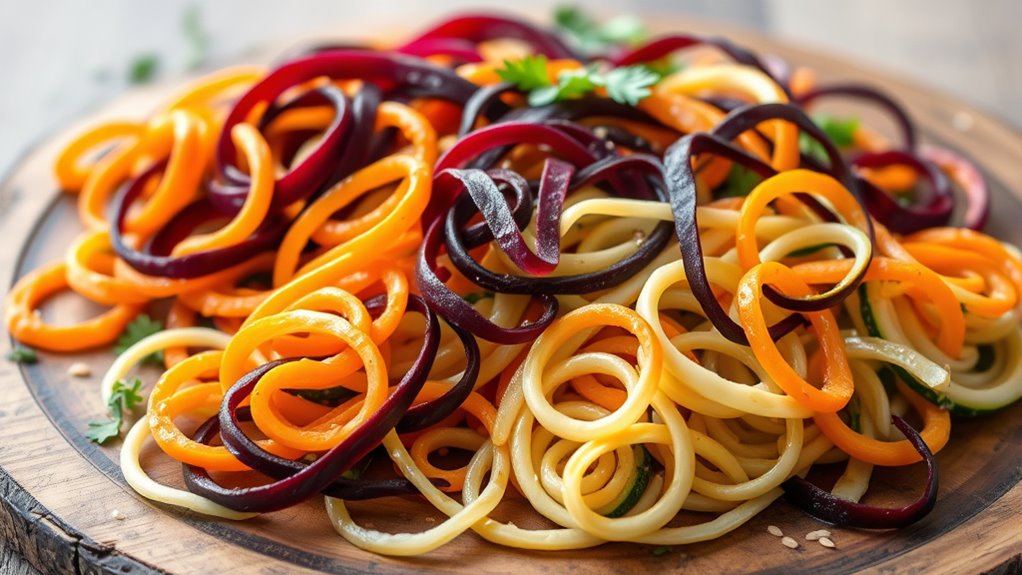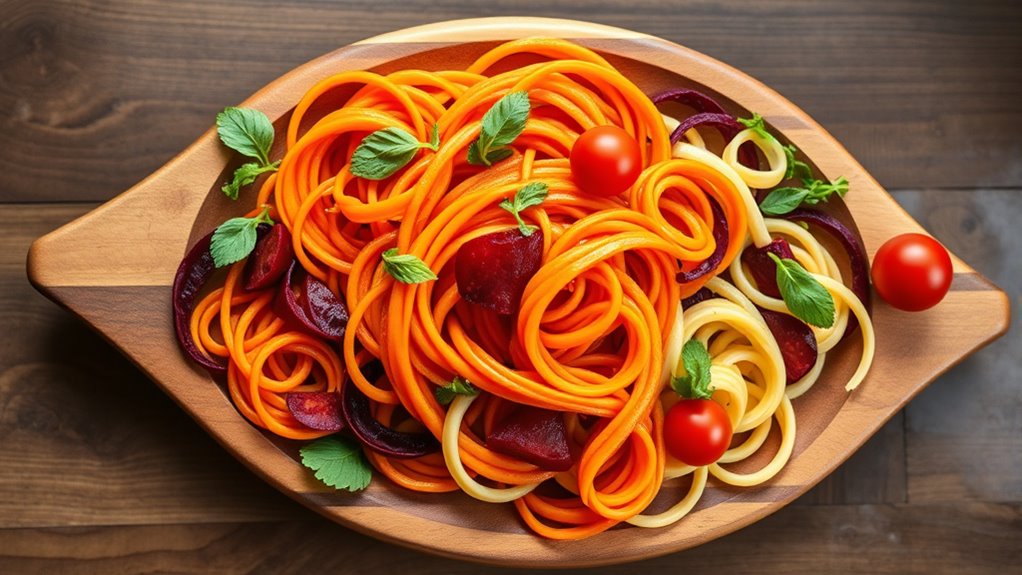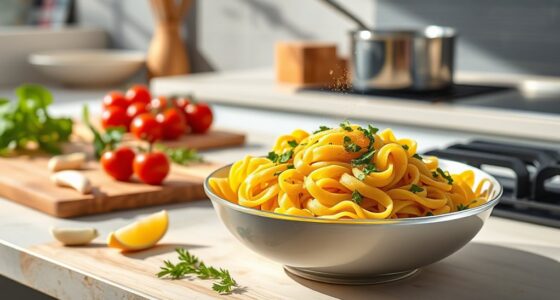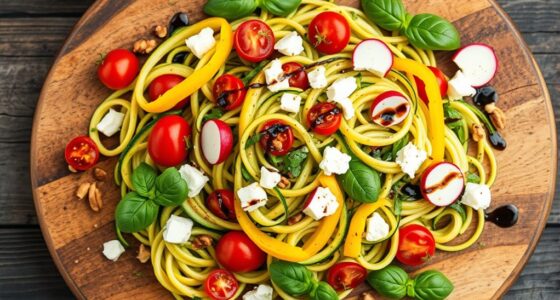Beyond zucchini, you can explore vibrant vegetable noodles made from carrots, beets, and sweet potatoes. Use a spiralizer to create delicate strands that add color and nutrition to your dishes. Carrots bring natural sweetness, beets offer earthiness and bold hues, while sweet potatoes add hearty texture. Experimenting with different vegetables and blade techniques will elevate your presentation and flavor. Keep exploring, as you’ll discover more creative ideas to diversify your meals.
Key Takeaways
- Incorporate colorful vegetables like carrots, beets, and sweet potatoes to diversify your vegetable noodle options.
- Use specific spiralizer blades, such as julienne or ribbon-cutting, for varied textures and optimal results.
- Be mindful of staining; use separate tools for stained vegetables like beets and clean tools properly after use.
- Store spiralized vegetables in airtight containers with damp paper towels to maintain freshness for up to 2 days.
- Experiment with cooking methods like sautéing, stir-frying, or eating raw to enhance flavor and presentation.

Vegetable noodles are a fun and healthy way to add more greens to your meals while satisfying your craving for pasta. When exploring beyond zucchini, you discover a world of colorful, nutrient-packed options like carrots, beets, and sweet potatoes. To get the most out of these vegetables, mastering spiralizer techniques is essential. With a good spiralizer, you can turn firm vegetables into delicate, spaghetti-like strands in seconds. For carrots and beets, use a julienne or ribbon-cutting blade to create varied textures, adding visual appeal and flavor to your dishes. Keep in mind that some vegetables, especially beets, can stain your spiralizer or cutting surfaces, so it’s wise to have separate blades or tools for different produce.
Master spiralizer techniques to create vibrant, healthy vegetable noodles from carrots, beets, and sweet potatoes.
Once you’ve spiralized your vegetables, proper storage becomes vital to maintain freshness and prevent spoilage. Vegetable storage tips come in handy here: store your spiralized veggies in airtight containers lined with a damp paper towel to keep them crisp. If you’re not using them immediately, place the container in the fridge, where they can stay fresh for up to a day or two. For longer storage, blanch the noodles briefly in boiling water, then freeze them in airtight bags. This not only extends their shelf life but also preserves their texture and flavor. When you’re ready to cook, you can sauté, stir-fry, or raw toss these veggie noodles into salads for a vibrant, nutritious meal.
Getting creative with vegetable noodles beyond zucchini opens up endless possibilities. Carrot noodles, for instance, bring a natural sweetness that pairs well with spicy or tangy sauces, while beet noodles add earthiness and a stunning deep purple hue. Sweet potatoes can be spiralized into a slightly starchy, sweet alternative perfect for baked dishes or hearty stir-fries. Don’t forget to experiment with different spiralizer blades and techniques to achieve the desired thickness and texture. Some vegetables, like carrots, work best with a julienne blade, while others, like sweet potatoes, may require a sturdier, thicker cut. Additionally, choosing the right tire pressure on gravel roads can enhance your comfort and safety when working with these fresh ingredients outdoors or in the kitchen.
Ultimately, the key is to keep your vegetables fresh and prepared properly. Using the right storage tips guarantees your spiralized creations stay crisp and flavorful until you’re ready to enjoy them. With a little practice and a bit of creativity, you’ll find vegetable noodles a versatile, colorful addition to your culinary repertoire, turning simple dishes into exciting, nutrient-rich meals.
Frequently Asked Questions
How Do I Prevent Vegetable Noodles From Becoming Soggy?
To prevent vegetable noodles from becoming soggy, you should focus on crisp texture and moisture control. Start by patting your noodles dry with a paper towel after spiralizing to remove excess moisture. Sauté them quickly over high heat, just until tender, to maintain crunch. Avoid overcrowding the pan, which traps moisture. Drain any excess liquid if you’re storing leftovers, and serve promptly to keep your noodles fresh and crisp.
What Tools Are Best for Spiralizing Different Vegetables?
When choosing tools for spiralizing different vegetables, consider the various spiralizer types like handheld, countertop, or electric models. Each suits different vegetables and prep needs. Use proper vegetable preparation techniques, such as peeling tougher skins and trimming ends, to guarantee smooth spiralizing. A versatile spiralizer with multiple blade options helps you create perfect noodles from carrots, beets, and more, making your veggie dishes both fun and visually appealing.
How Long Can Vegetable Noodles Be Stored Safely?
Think of your veggie noodles as fleeting moments of freshness. You can store them for 1 to 3 days in the fridge, but watch for spoilage signs like sliminess or bad odor. Proper storage duration preserves their essential quality, preventing spoilage signs that mark the end of their journey. If longer preservation is needed, consider freezing, but enjoy them promptly to savor their vibrant taste and texture.
Can Vegetable Noodles Be Cooked in the Microwave?
Yes, you can microwave vegetable noodles. Simply place them in a microwave-safe dish, add a splash of water to help steam, and cover loosely. Microwave in short intervals, around 30 seconds to a minute, checking their vegetable texture. This method preserves their crunch and flavor while cooking quickly. Just be careful not to overcook, as microwave cooking can make them soggy if left too long.
Are There Specific Flavor Pairings for Non-Zucchini Vegetable Noodles?
Think of your vegetable noodles as a blank canvas waiting for a splash of flavor. When it comes to flavor pairing, you want to choose ingredients that sing in harmony. Carrots crave the sweet embrace of honey or ginger, while beets shine with tangy citrus or sharp horseradish. Use complementary ingredients like garlic, sesame, or fresh herbs to elevate your noodles and create a symphony of taste.
Conclusion
As you twirl a vibrant carrot or a ruby beet into your bowl, you can almost taste the crunch and sweetness bursting with every bite. These colorful vegetable noodles turn your plate into a lively garden scene—each strand a fresh, crisp surprise. So, go ahead, experiment beyond zucchini and transform ordinary meals into a vivid, flavorful feast. With each spiral, you’re not just cooking—you’re creating a beautiful, nourishing masterpiece that excites your senses and brightens your day.










